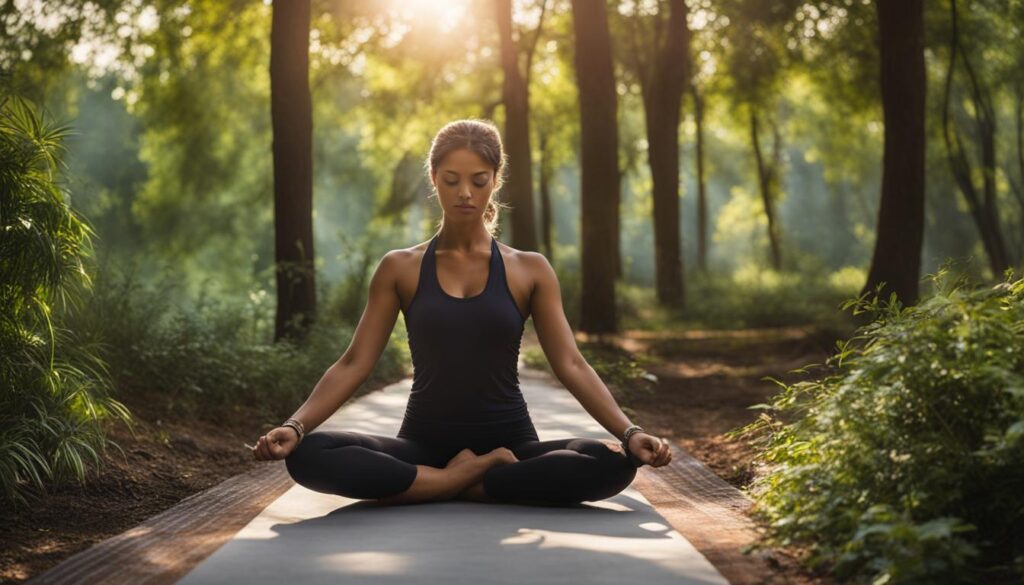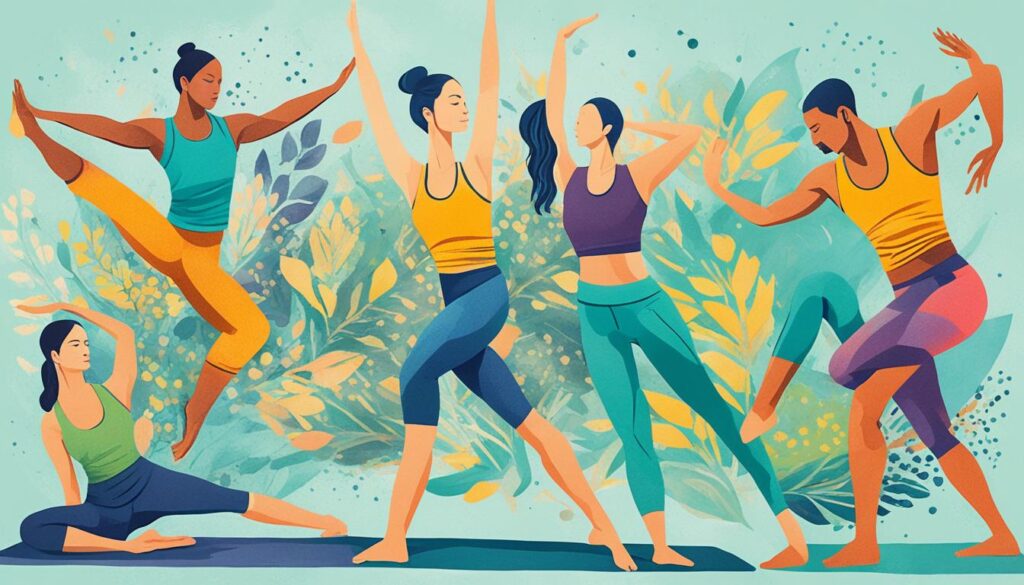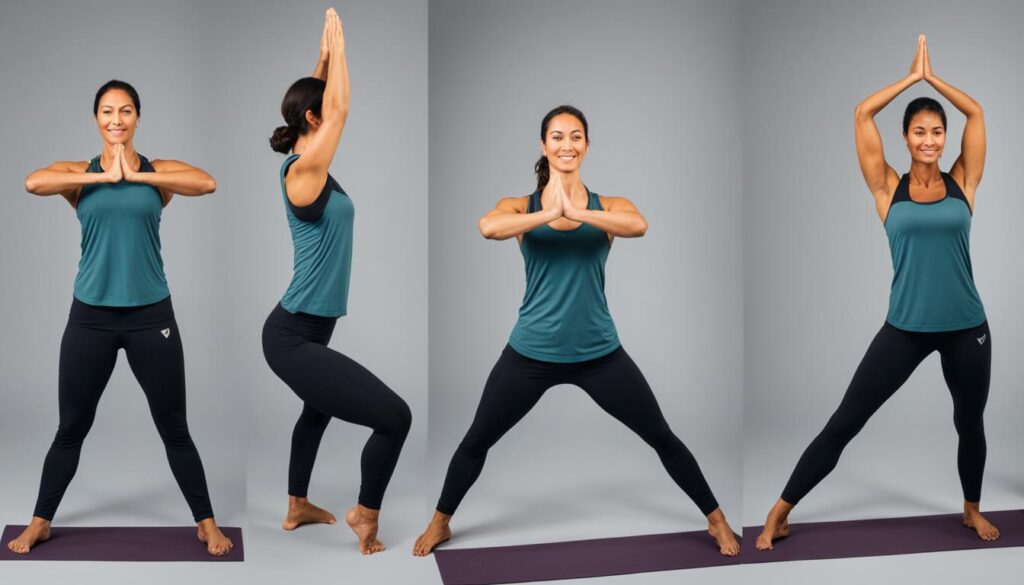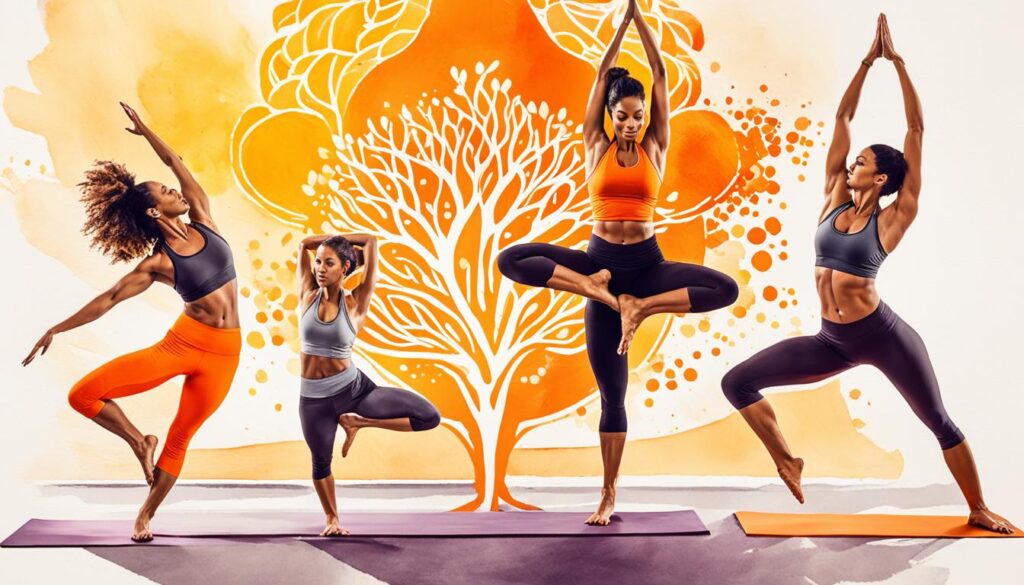Welcome to the diverse and fascinating world of yoga. In this article, I will introduce you to two popular yoga styles – Hatha and Vinyasa. Yoga is much more than physical exercise. It’s a holistic practice that cultivates mindfulness, inner peace, and spiritual growth.
Hatha and Vinyasa are two distinct styles of yoga that suit different needs and preferences. Let’s explore their unique characteristics and benefits, so you can choose the practice that resonates with you.
Key Takeaways:
- Hatha and Vinyasa yoga are two popular yoga styles worth exploring.
- Yoga is a holistic practice that promotes mindfulness, inner peace, and spiritual growth.
- Choosing the right yoga style is essential for your wellness journey.
- Hatha yoga is a gentle and traditional style that emphasizes physical postures and breath control.
- Vinyasa yoga is a flow yoga that promotes strength, flexibility, and mindfulness through dynamic movement.
What is Hatha Yoga?
Hatha yoga is a traditional style of yoga practice that dates back to the 15th century in India. This style emphasizes physical postures, or asanas, and breath control, or pranayama. Its gentle approach makes it suitable for beginners and practitioners of all levels.
Unlike other modern styles of yoga, Hatha yoga has a slower pace, with each pose held for several breaths. This allows for deeper relaxation, increased body awareness, and improved flexibility.
The practice of Hatha yoga also includes meditation and mindfulness techniques, which can calm the mind, reduce stress, and promote mental and emotional well-being. As such, Hatha yoga has a range of benefits for overall health, including:
- Better flexibility and increased muscle tone
- Improved respiratory function and cardio health
- Reduced stress and anxiety levels
- Higher levels of concentration and focus
- Enhanced spiritual awareness and inner peace

The Origins of Hatha Yoga
The term “Hatha” comes from the Sanskrit words “ha” and “tha,” which translate as “sun” and “moon,” respectively. This represents the balance between opposing elements – masculine and feminine, active and passive, hot and cold – that Hatha yoga seeks to achieve.
The first written text on Hatha yoga is the Hatha Yoga Pradipika, compiled by the sage Svatmarama in the 15th century. This text, along with many other ancient scriptures, has influenced the development of modern yoga practices.
Hatha Yoga Asanas
Hatha yoga includes a variety of asanas that range from simple to advanced. Some common poses include:
| Asana | Benefits |
|---|---|
| Mountain pose (Tadasana) | Improves posture, balance, and concentration |
| Cobra pose (Bhujangasana) | Stretches the chest, shoulders, and spine; tones the abdomen |
| Downward-facing dog pose (Adho Mukha Svanasana) | Strengthens the arms and legs; lengthens the spine; relieves stress |
| Tree pose (Vrikshasana) | Improves balance and stability; strengthens the legs and core |
These asanas can be practiced individually or combined into a sequence, or “flow,” to create a full Hatha yoga class.
If you’re looking for a gentle, holistic, and beginner-friendly yoga practice that offers a wide range of benefits for your mind and body, Hatha yoga is an excellent choice.
Understanding Vinyasa Yoga
Vinyasa yoga, also known as flow yoga, is a dynamic and challenging practice that focuses on smoothly transitioning between poses, synchronized with breath. The word “vinyasa” means “to place in a special way,” emphasizing the creative and flowing nature of this style. It often involves sequences of poses that build heat, strength, flexibility, and mindfulness.
Unlike Hatha yoga, which follows a set sequence of postures, Vinyasa yoga allows for more creativity and flexibility in sequencing. Practitioners can select different postures and combine them into a unique flow, making each practice session a new experience.

One of the distinctive features of Vinyasa yoga is the emphasis on the breath. The synchronization of breath and movement helps to cultivate a deep mind-body connection and enhance the quality of the practice. In a Vinyasa class, the instructor will usually guide the students through Sun Salutations, a series of poses that warm up the body and energize the mind.
Overall, Vinyasa yoga is a popular choice for those who crave a physically challenging and mentally stimulating practice that integrates movement, meditation, and breathwork.
The Key Differences Between Hatha and Vinyasa Yoga
Hatha yoga and Vinyasa yoga are two distinct styles with a few similarities. Understanding the differences between the two can help you choose which practice aligns with your goals and preferences.
Pace and Structure
Hatha yoga: The pace of Hatha yoga is slow and gentle, with longer holds of poses to foster relaxation and focus. It follows a structured sequence, moving from one pose to another with brief breaks in between.
Vinyasa yoga: Vinyasa yoga is more dynamic and fast-paced, involving a continuous flow of movements synchronized with breath. It has no fixed sequence and allows for more variability in the order and types of poses.
Philosophical Foundations
Hatha yoga: The philosophical foundation of Hatha is rooted in the concept of balancing and harmonizing the opposites – the sun (ha) and moon (tha). This style emphasizes the need to achieve a stable and calm mind through physical practice.
Vinyasa yoga: Vinyasa yoga’s origins lie in the ancient tradition of Ashtanga yoga. It emphasizes the connection between movement and breath, while also encouraging the practitioner to embrace spontaneity and creativity during the practice.

Hatha vs. Vinyasa: While Hatha is all about balance and relaxation, Vinyasa is a challenging and dynamic practice that rewards perseverance and self-discipline.
By understanding the fundamental differences between Hatha and Vinyasa yoga styles, you can make a more informed decision about which one resonates with you. However, keep in mind that the two practices can complement each other, and may even be included in a single session or class.
Exploring Common Yoga Poses in Hatha and Vinyasa Yoga
In this section, we will take a closer look at some common yoga poses in both Hatha and Vinyasa yoga. These poses form the foundation of both styles and provide numerous health benefits. By understanding these postures, you will have a better idea of what to expect when practicing these styles.
Hatha Yoga Poses
Hatha yoga poses are generally practiced slowly and held for a longer duration, allowing the body to deepen into the stretch. Here are some common Hatha yoga poses:
| Yoga Pose | Description | Benefits |
|---|---|---|
| Tadasana (Mountain Pose) | Standing pose with feet hip-width apart and arms at sides. | Improves posture, strengthens legs and feet, relieves stress and anxiety. |
| Uttanasana (Standing Forward Bend) | Standing pose with feet hip-width apart and hands reaching towards the floor. | Stretches hamstrings and spine, relieves tension in neck and back. |
| Bhujangasana (Cobra Pose) | Lying on the stomach with hands under shoulders, lifting chest and head. | Stretches chest and shoulders, strengthens back muscles, improves posture. |
Tip: If you are a beginner, start with these poses and hold each pose for at least 5 breaths before moving on to the next.

Vinyasa Yoga Poses
Vinyasa yoga poses are often practiced in a flowing sequence, synchronized with breath. Here are some common Vinyasa yoga poses:
- Adho Mukha Svanasana (Downward-Facing Dog)
- Chaturanga Dandasana (Four-Limbed Staff Pose)
- Urdhva Mukha Svanasana (Upward-Facing Dog)
- Virabhadrasana I (Warrior I Pose)
These poses are often linked together in a series called Sun Salutation (Surya Namaskar), which is commonly practiced at the beginning of a Vinyasa yoga session.
Tip: To get the most out of Vinyasa yoga, flow through these poses continuously, linking them with each inhale and exhale.

Benefits of Hatha Yoga for Mind and Body
Hatha yoga is a diverse and accessible style of yoga that can benefit practitioners of all levels. Through a combination of physical postures (asanas) and breath control (pranayama), Hatha yoga creates a foundation for improved overall well-being. Let’s dive deep into some of the key benefits of practicing Hatha yoga:
Increased Flexibility
One of the primary benefits of Hatha yoga is increased flexibility. Through consistent practice, Hatha yoga can help improve flexibility in the muscles and joints of the body, supporting healthy mobility and range of motion. This can also help reduce the risk of injury in other physical activities.
Muscle Toning
Hatha yoga poses require the engagement of various muscle groups, which can help tone and strengthen the body. Not only can this improve physical appearance, but it can also increase overall strength and support proper posture.
Stress Reduction
The slow and intentional movements of Hatha yoga can help reduce stress and tension in the body. The focus on breath control can also assist in reducing anxiety and promoting a sense of calm and relaxation.
Improved Mental Focus
Through the combination of physical movement and breath work, Hatha yoga promotes improved mental focus and concentration. The practice emphasizes being present in the moment, which can help cultivate mindfulness and increase mental clarity.
An Excellent Choice for Beginners
Hatha yoga is considered a gentle and approachable style, making it an excellent choice for beginners or individuals with physical limitations. The slow and deliberate movements emphasize proper alignment and modifications, allowing practitioners to safely learn and progress in their practice.
A Holistic Practice
Finally, Hatha yoga is a holistic practice that offers benefits not only to the physical body, but also to the mind and spirit. Through its combination of physical movement, breath control, and mindfulness, Hatha yoga supports overall well-being and can be a valuable addition to any wellness routine.
Energize and Empower with Vinyasa Yoga
Vinyasa yoga is a dynamic style that helps to build strength, enhance cardiovascular health, and create a deep mind-body connection. This style of yoga is known for its transformative power. In Vinyasa yoga, the movements are coordinated with breath, creating a flow that challenges practitioners to stay present and focused. This makes it a great style for those who want to energize their body and empower their mindset.
If you are a beginner, Vinyasa yoga can be an excellent way to ease into the practice. The emphasis on movement and breath creates a moving meditation that can help quiet the mind and reduce stress. With consistent practice, you can build endurance, improve flexibility, and increase muscle tone.
Like all styles of yoga, Vinyasa offers many benefits for the mind and body. Some of the most notable benefits include:
- Improved cardiovascular health: The flowing movements of Vinyasa yoga can help increase heart rate and circulation, which benefits overall cardiovascular health.
- Enhanced strength and flexibility: The diverse range of poses and movements in Vinyasa yoga can help strengthen and tone muscles, as well as enhance flexibility and balance.
- Increased mindfulness: The focus on breath and movement helps to cultivate a deep mind-body connection, promoting present-moment awareness and reducing stress and anxiety.
- Stress reduction: The flowing movements of Vinyasa yoga can help release tension and reduce stress, promoting relaxation and calmness.
Take the time to explore Vinyasa yoga in your practice and discover the transformative power it can offer.
Finding the Right Yoga Classes and Sequences
Now that you have a solid understanding of Hatha and Vinyasa yoga, it’s time to put your knowledge into practice by exploring the various options for yoga classes and sequences. Here are some factors to consider when selecting the right yoga class to suit your needs:
- Experience level: Are you a beginner or an advanced practitioner?
- Style: Are you interested in a specific style of yoga, such as Hatha or Vinyasa?
- Teacher: Do you have a preference for a certain teacher or teaching style?
- Cost and location: Is the studio conveniently located and within your budget?
Once you have found the right yoga class, you can start experimenting with creating your own yoga sequences. This allows you to target specific areas of the body or address particular concerns, such as stress relief or improving flexibility. Be sure to listen to your body and adjust your sequences as needed based on your comfort level.
Sample Yoga Sequence
Here’s a simple Hatha yoga sequence to get you started:
| Poses | Benefits |
|---|---|
| Mountain Pose (Tadasana) | Improves posture and promotes relaxation |
| Tree Pose (Vrikshasana) | Strengthens ankles, calves, and thighs |
| Downward-Facing Dog (Adho Mukha Svanasana) | Stretches hamstrings, calves, and spine |
| Child’s Pose (Balasana) | Relieves stress and fatigue |
| Cobra Pose (Bhujangasana) | Strengthens back muscles and improves flexibility |
Add or remove poses to make this sequence your own. Remember, yoga is all about finding what works best for you and your body.
Exploring Other Yoga Styles and Their Benefits
While Hatha and Vinyasa yoga are among the most popular styles, there are numerous other yoga practices that are worth exploring. Each style offers unique benefits and characteristics that cater to various needs and preferences. Let’s take a brief look at some of these styles:
| Name of Yoga Style | Unique Characteristics | Benefits |
|---|---|---|
| Ashtanga yoga | A fast-paced, physically demanding practice that combines sequential movement with breath | Improves strength, stamina, and flexibility; promotes weight loss and detoxification; enhances mental focus and clarity |
| Bikram yoga | A style that consists of 26 set postures practiced in a heated room for 90 minutes | Improves muscle flexibility and balance; detoxifies the body; helps with weight loss and stress reduction |
| Yin yoga | A slow-paced, meditative practice that involves holding poses for several minutes at a time | Increases flexibility and joint mobility; reduces stress and anxiety; facilitates deeper relaxation and meditation |
By trying out different yoga styles, you can expand your practice and benefit from a variety of physical and mental advantages. Whether you prefer a vigorous flow or a gentle stretch, there is a yoga style that suits your needs and goals. Remember, the beauty of yoga is its versatility, so don’t be afraid to step out of your comfort zone and explore new styles.
Conclusion
As an experienced yoga practitioner, I have explored various styles and witnessed the transformative power of this ancient practice. Through this article, I have shared with you my insights into Hatha and Vinyasa yoga, two popular styles that offer unique benefits for the mind, body, and spirit.
Regardless of the style you choose, establishing a regular yoga practice can have numerous benefits, such as improved flexibility, reduced stress, and enhanced self-awareness. By incorporating yoga into your daily routine, you can cultivate a healthier, more balanced lifestyle.
Remember, yoga is a personal journey, and there is no one-size-fits-all approach. It’s essential to find a style that resonates with you and a teacher who can guide you through the practice safely and effectively.
Whether you prefer the gentle approach of Hatha yoga or the dynamic flow of Vinyasa yoga, or wish to explore other styles such as Ashtanga or Bikram, there is a yoga practice that suits your goals and preferences.
Embrace the many benefits of yoga and build a sustainable practice that supports your overall well-being. Thank you for joining me on this journey through different yoga styles, and I wish you a fulfilling yoga practice ahead.
FAQ
What is Hatha yoga?
Hatha yoga is a traditional style that emphasizes physical postures (asanas) and breath control (pranayama). It is known for its gentle approach and is suitable for beginners and practitioners of all levels.
What is Vinyasa yoga?
Vinyasa yoga, often referred to as flow yoga, focuses on smoothly transitioning between poses, synchronized with breath. It offers a dynamic and challenging practice that promotes strength, flexibility, and mindfulness.
What are the key differences between Hatha and Vinyasa yoga?
While Hatha and Vinyasa yoga share some similarities, they also have significant differences. Hatha yoga is slower-paced, with more static postures, while Vinyasa yoga is faster-paced and emphasizes flowing movements. Additionally, Hatha yoga focuses on aligning the body and mind, while Vinyasa yoga prioritizes linking breath with movement.
What are some common yoga poses in Hatha and Vinyasa yoga?
Both Hatha and Vinyasa yoga incorporate a range of fundamental poses. Some common poses include downward facing dog, warrior poses, tree pose, and child’s pose.
What are the benefits of Hatha yoga?
Hatha yoga offers numerous benefits for the mind and body. It can increase flexibility, improve muscle tone, reduce stress, enhance mental focus, and promote overall well-being. It is also a great choice for beginners.
What are the benefits of Vinyasa yoga?
Vinyasa yoga invigorates and empowers practitioners. It can build strength, enhance cardiovascular health, foster a deep mind-body connection, and promote a sense of flow and creativity.
How do I find the right yoga classes and sequences?
To find the right yoga classes, consider factors such as your experience level, preferences, and goals. Look for reputable studios or certified instructors. If you prefer practicing at home, you can also find online classes or create your own sequences based on your needs.
What other yoga styles are worth exploring?
Besides Hatha and Vinyasa yoga, there are many other styles to explore, such as Ashtanga, Bikram, and Yin yoga. Each style offers unique benefits and characteristics, catering to different preferences and goals.
Why should I practice yoga?
Yoga provides numerous benefits for the mind, body, and spirit. It can improve flexibility, strength, posture, and cardiovascular health. Additionally, yoga promotes stress reduction, mental clarity, mindfulness, and overall well-being.


Leave a Comment